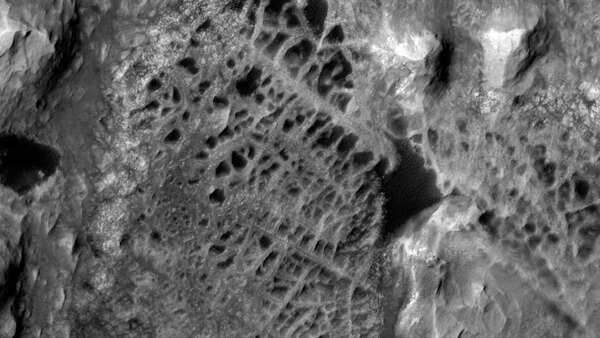NASA's Curiosity rover has transmitted unprecedented close-up images of peculiar, spiderweb-like rock formations on the Martian surface. These intriguing structures are providing valuable insights into the planet's ancient, water-rich past.
Discovered on the slopes of Mount Sharp within Gale Crater, where Curiosity has been actively exploring since 2012, these mysterious, zig-zagging formations are known as "boxwork." These elaborate, mineral-rich ridges are believed to have originated from ancient groundwater activity, creating web-like patterns when viewed from above. Scientists are optimistic that these formations may contain crucial clues regarding Mars' potential to have supported microbial life in the distant past.
What are Martian "spiderwebs" that are captured by NASA?

Despite their nickname, these "spiderwebs" aren't the work of Martian insects. Instead, they are geological features called boxwork. This pattern of intersecting mineral ridges forms when groundwater permeates cracks in the rock, leaving behind mineral deposits. Over time, softer surrounding rock erodes away due to wind, revealing the hardened, web-like framework beneath.
Although boxwork formations have been observed from orbit, this is the first instance of their close examination on Mars. Curiosity reached this location in early June 2025, following months of navigating Mount Sharp. On June 23, NASA released both images and an interactive 3D video of these formations, highlighting their unique structure and enigmatic location as a top scientific priority.

Analysis of the surrounding rocks has revealed veins of calcium sulfate, a salty mineral commonly deposited by groundwater. These findings suggest that the area was once abundant in liquid water, and the subsurface environment may have been warm and salty – potentially suitable for microbial life, akin to certain regions on early Earth.
It's important not to confuse the newly imaged boxwork formations with the so-called "spiders on Mars." Those dark, radial patterns are caused by carbon dioxide ice erupting from beneath the surface. Unlike those seasonal phenomena, boxwork is permanent and mineral-based, formed through geological – not atmospheric – processes.
Scientists speculate that these formations could play a significant role in resolving the debate about whether Mars once harbored life. The mineral composition, protected underground conditions, and evidence of flowing water all indicate an environment that could have sustained microbial organisms. According to Curiosity mission scientist Kirsten Siebach, "Early Earth microbes could have survived in a similar environment."
Curiosity will continue to study this patch of boxwork on Mount Sharp, gathering samples and performing detailed chemical analysis. Researchers hope that these unique structures will not only provide further insights into Mars' climate history but also aid in guiding future missions in the search for signs of life beneath the Martian surface.
Newer articles
Older articles
 Team India Settles in Birmingham: Rahul's Mattress, Coaches' Strolls, and the Enduring Coffee Ritual
Team India Settles in Birmingham: Rahul's Mattress, Coaches' Strolls, and the Enduring Coffee Ritual
 Android Users Urged to Patch Devices Immediately Following Critical Security Flaws Alert
Android Users Urged to Patch Devices Immediately Following Critical Security Flaws Alert
 Ashada Gupt Navratri 2025: Dates, Auspicious Timings, and Esoteric Significance Explained
Ashada Gupt Navratri 2025: Dates, Auspicious Timings, and Esoteric Significance Explained
 JPG to PDF: A Graphic Designer's Guide to Conversion & Best Practices
JPG to PDF: A Graphic Designer's Guide to Conversion & Best Practices
 Skin Cancer Alert: How to Identify Suspicious Moles and Early Warning Signs
Skin Cancer Alert: How to Identify Suspicious Moles and Early Warning Signs
 IRCTC's AskDisha 2.0: AI Chatbot Streamlines Train Ticket Booking, Refunds, and Travel Information
IRCTC's AskDisha 2.0: AI Chatbot Streamlines Train Ticket Booking, Refunds, and Travel Information
 The stat that could swing every NBA team's 2025-26 season
The stat that could swing every NBA team's 2025-26 season
 Bollywood's Mythological Muse: How Indian Epics Inspire Cinematic Storytelling
Bollywood's Mythological Muse: How Indian Epics Inspire Cinematic Storytelling
 Bollywood Flashback: Jackie Shroff Accused of Untoward Advance on Young Tabu at Danny Denzongpa's Party
Bollywood Flashback: Jackie Shroff Accused of Untoward Advance on Young Tabu at Danny Denzongpa's Party
 Popular Finance YouTuber's Account Hacked: Bitcoin Scam Alert and Security Tips
Popular Finance YouTuber's Account Hacked: Bitcoin Scam Alert and Security Tips